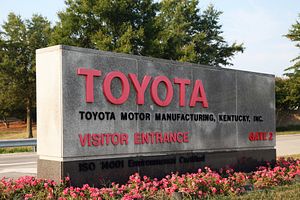This is the first of a five part series on the relationship of the Commonwealth of Kentucky with the Asia-Pacific. The first installment focuses on TMMK, the largest Toyota production plant in North America. Future installments will profile Kentucky’s two senators, Rand Paul and Mitch McConnell, examine the explosion in bourbon demand across East Asia, and study other ways in which a single, landlocked American state has affected, and been affected by, America’s ties to the Asia-Pacific.
When people in Kentucky think “American made cars,” they think of the Corvette facility in Bowling Green, or of Toyota Motor Manufacturing, Kentucky (TMMK) in Georgetown. Opened in 1988, TMMK is the largest Toyota production facility in North America. The facility employs 7,000 people, and produces most of the Camrys available in the North American market.
Why would Toyota build a factory in Georgetown, Kentucky? Mostly, because of the Voluntary Export Restraint (VER) Japan agreed to in 1981 with respect to automobile sales. When Japan accepted a strict limit on the number of cars it could send to the United States, Japanese companies took an alternative route to engaging the American market. Japanese cars produced in the United States don’t count against the VER; thus, TMMK and its counterparts allowed Toyota full access to American car-buyers.
Georgetown, Kentucky wasn’t the only site considered, but it was attractive to Toyota for a number of reasons. It is centrally located, with access to both the Midwest and to the upper South. The state government, lacking much in the way of heavy industry to boast of, went out of its way to make Georgetown alluring to the Japanese firm, offering $147 million in inducements. Another reason is the Kentucky, unlike the traditional car-producing states of the upper Midwest, does not have a strong local tradition of industrial unions. Toyota does not have a unionized workforce at any of its North American plants (although TMMK was constructed by unionized contractors); it famously shut down NUMMI after General Motors pulled out of a joint venture between the two companies.
Over the years, Toyota’s labor policies have sparked controversy. Labor advocates argue that while Toyota pays good wages, its widespread use of temporary workers inhibits efforts at unionization. Moreover, Toyota has sustained consistent criticism regarding the frequency of injuries along the production line. Although Toyota maintains (with some cause) that the TMMK workforce does not support unionization, the broader effect of Japanese investment in the U.S. auto industry has almost certainly worked against sector unionization. This stands in contrast to German investment, which is generally seen as supportive of union activity.
The economic impact on Kentucky has undoubtedly been huge. TMMK helped revitalize the Bluegrass region (broadly speaking, the north central area of the state, centered on the Lexington-Louisville-Cincinnati triangle), creating ancillary industries and service sector improvements. Most analyses of TMMK’s impact suggest that it has had a major effect on industrial employment in the region, vastly exceeding the expectations of 1987.
TMMK came to Kentucky during a period of stress between Japan and the United States, with Washington making near-constant complaints about Japanese trade practices. The wounds of World War II were fresher in the 1980s than they are today. The Kentucky state government pushed hard against this tide, making clear that Toyota was welcome in the area. Indeed, many argued that it pushed too hard; the inducement package produced protests, and became a key issue in the 1987 Kentucky gubernatorial campaign.
Scott County, and Georgetown itself, have been transformed by the presence of the plant, shifting from a depressed agricultural region to a bustling industrial part of the greater Lexington metropolitan area. Not everyone in the region saw this as a positive, but the prospect of jobs and money sidelined opposition. The arrival of TMMK also wrought a cultural shift in Georgetown and nearby Lexington, with Japanese managers and families arriving, and bringing with them an unfamiliar language and cuisine.
Indeed, on the Japanese side, Toyota officials had some trouble convincing executives that Kentucky was anything other than a rural, backwoods part of the United States. But the importance of TMMK to Toyota’s international operation became clear when Fujio Cho, who had headed TMMK for six years, became the CEO of the company in 1999.
Cho was known for his focus on environmental issues, and as such it’s little surprise that TMMK has become an exemplary environmental citizen. A Kentucky government official told me “they are actually one of the best environmental stewards in the state. They have on site renewable energy, and have implemented aggressive energy efficiency measures over the past decade.”
Georgetown is not what it was 30 years ago, and the change has had ripple effects across the Commonwealth. The 2001 volume Japan in the Bluegrass, based on a 1999 colloquium at the University of Kentucky, detailed the social, economic, and environmental impact of TMMK a decade on. Toyota has had its own problems in the United States in the ensuing years, including a massive Camry recall in 2011, but its position in the Bluegrass seems secure.
































